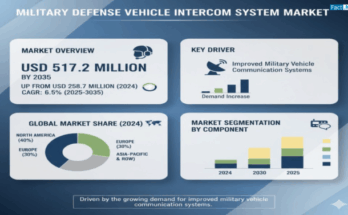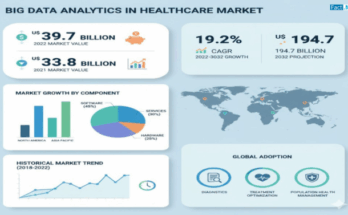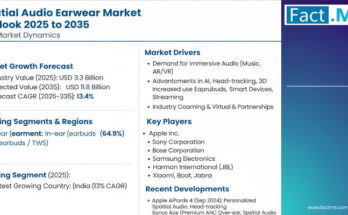The global contactless biometrics market is poised for exponential growth, driven by surging demand for touch-free authentication across high-security sectors, advancements in multimodal systems, and growing privacy-conscious adoption. The market, currently valued at approximately US$ 22.8 billion, is projected to expand significantly over the next decade.
Key Market Dynamics
The shift toward contactless biometric technologies — including facial recognition, voice scanning, iris recognition, and vein-pattern detection — has accelerated in recent years, especially under heightened hygiene and security concerns. Multimodal biometric systems, which combine two or more biometric modalities, are emerging as a preferred choice in sectors like government, defense, healthcare, and finance.
Security incidents, identity theft, and unauthorized access are motivating organizations to adopt more reliable, non-contact authentication methods. The high reliability of contactless biometrics helps organizations strengthen identity verification while ensuring user convenience.
Forecast Through 2035
-
The United States is predicted to be a major growth engine, with the market expected to grow at a 15.2% compound annual growth rate (CAGR) from 2025 to 2035, reaching an estimated US$ 13.8 billion by 2035.
-
Globally, contactless biometrics solutions are projected to experience sustained growth as organizations continue to innovate with advanced modalities and integrate them into identity management.
What’s Driving Adoption
-
Post‑Pandemic Acceleration
The COVID-19 pandemic served as a catalyst, pushing demand for touchless authentication systems. Technologies such as contactless fingerprint, face, voice, and vein recognition gained broader acceptance in public spaces, airports, and workplaces. -
Technological Innovation
Next-generation contactless biometric systems now support 3D facial recognition, sophisticated vein-pattern scanning, and AI-enhanced multimodal systems. These innovations provide stronger security, higher accuracy, and lower false-acceptance rates. -
Rising Security Threats
Sectors with stringent security requirements — such as defense, government, critical infrastructure, and finance — are increasingly deploying contactless biometrics to combat fraud and bolster access control. -
Strategic Focus on Innovation
Companies are heavily investing in R&D to develop biometric systems with next-gen sensors, multi-modal capabilities, and privacy-preserving architectures. New entrants are differentiating themselves through unique technological offerings. -
Privacy and Data Protection Challenges
While demand is growing, high costs associated with advanced solutions and concerns over biometric data storage and privacy remain significant barriers. Organizations must navigate public concerns around data protection and regulatory compliance.
Segment Insights
-
By Technology: The most advanced contactless systems utilize multimodal biometrics (combining face, voice, vein, etc.), but single-mode solutions like face or voice recognition remain widely used.
-
By End-User: High-security verticals such as defense, government, finance, and healthcare lead adoption due to their stringent access control needs.
-
By Component: Solutions include hardware (sensors), software (recognition algorithms), and services (deployment, maintenance).
Regional Highlights
The United States is a key market for contactless biometrics, capturing a large share of North America. Its robust defense investment, proactive cybersecurity policies, and adoption of biometric identity systems make it a focal area for vendors. Other regions, including Asia and Europe, are also showing strong interest in contactless identity systems, especially for public-sector and border security applications.
Competitive Landscape
Leading companies in the contactless biometrics space are pushing innovation in sensor design, AI-based recognition, and multimodal integration. Major players are focusing on research partnerships, new product launches, and strategic alliances to stay competitive.
Future Outlook: Smart, Secure, and Touch-Free
Over the next decade, the contactless biometrics market is expected to evolve significantly:
-
Integration with AI and Edge Computing: Real-time analysis of biometric data at the edge will reduce latency and improve security.
-
Privacy‑Preserving Biometrics: New architectures will enable biometric matching without storing raw biometric data, addressing privacy concerns.
-
Broad-Based Deployment: Beyond security use cases, contactless biometrics will find wider applicability in consumer devices, smart cities, and healthcare.
-
Cost Reductions: Advances in sensor technology, mass production, and component cost optimization will lower system costs, increasing adoption across SMBs.
“Contactless biometrics is no longer a niche technology — it’s becoming the backbone of secure, frictionless identity systems worldwide,” said a market analyst. “As organizations balance security, convenience, and privacy, the next-generation of touch-free solutions will redefine how identity is managed.”
Browse Full Report : https://www.factmr.com/report/contactless-biometrics-market
About Fact.MR
Fact.MR is a trusted market research and consulting firm delivering data-backed insights across industries. Their mission is to help clients make informed, strategic decisions through rigorous analysis and foresight.



